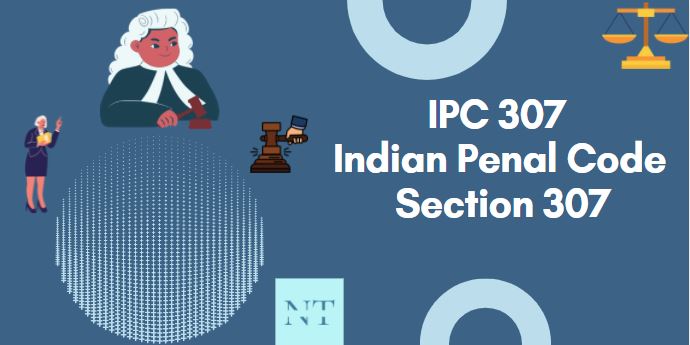IPC 307: Section 307 of the Indian penal code states that any individual perpetrating an act with such motive or knowledge, and under such conditions that, if he by that act resulted in demise, he would be culpable of homicide, and shall be castigated with the incarceration of either, by a manner of an interval which may extend up to a decade, and shall also be susceptible to compensate a fine; and, if the damage is inflicted to any individual by such ordinance, the offender shall be likely either to imprisonment for life or to such sentence as is hereinbefore mentioned.
Table of Contents
Summary of IPC 307
| If such an act causes hurt or injury to any individual Punishment: | Imprisonment for Life or 10 Years with a penalty Fine Cognizance: Cognizable Bail: Non-Bailable Triable: Court of Session | |
| Attempt to murder Punishment: | 10 Years + Fine Cognizance Cognizable Bail Non-Bailable Triable Court of Session | |
| An attempted life-convict to murder, if hurt is caused Punishment: | Death or 10 Years + Fine Cognizance Cognizable Bail Non-Bailable Triable Court of Session |
Examples of Section 307 in the Indian Penal Code
If Jared shoots Karen and the incidents of casualty ensue, Jared would be guilty of murder. Jared is accountable for penalties under this Section.
Jared, despite being in tender years, endangers him in a wasteland. Jared has perpetrated the violation specified by this section, even though the death of the junior does not occur.
Jared, aspiring to murder Karen, purchases a firearm and loads it. Jared has not yet committed the crime, Jared shoots the gun at Karen. He has committed the violation illustrated in this section, and if by such firing he injures Karen, he is accountable to the sentence procured by the last portion of the initial passage of this Section.

Jared, planning to kill Karen with toxin-like poisons buys it and compounds it with food that Karen keeps; Jared has not yet executed the crime defined in this Section. Jared places the diet on Karen’s table or sends it to Karen’s servants to place it on Karen’s table. Jared has executed the crime defined in this section.
Crucial Ingredients for Attempt to Murder under Section 307
The requirements to advocate for an offense under Section 307 (Attempt to Murder) of the Indian Penal Code are:
The essence of the Act:
The act endeavored should be of such a nature that if not deterred or intercepted, it would lead to the death of the sufferer.
Motive or knowledge of committing the offense:
The motive to kill is required to be substantiated clearly beyond an adequate suspicion. To verify this, the prosecution can make use of the conditions like an assault by hazardous weapons on critical body parts of the casualty, however, the motive to kill cannot be gauged merely by the gravity of the damage induced to the victim.
Performance or execution of offense:
The motive and the awareness arising in the venture to kill by the accused is also needed to be ascertained for conviction under the section.
The act by the culprit would result in death in its ordinary course.
The requirement to substantiate a crime of Murder under Section 302 of the Indian Penal Code is
An Intent to cause death:
The explained action must be performed with the understanding that the act is likely to result in the death of a distinct person.
There should be a motive to inflict such physical damage that is likely to cause death.
The spectrum of Section 307 of the Indian Penal Code
Section 307 deals with the violation of an empty murder. This Section pertains to when an effort is taken by someone, that would, in its normal course, result in the death of another person, but for some reason or the other, did not.
Penalty for Attempt to Murder under IPC- Section 307
According to the Indian Penal Code, for an endeavor to murder, the freight relies on the degree and also if the guilty is a life convict.
In an undertaking to commit murder, if the action concludes in any laceration to any person, then the culprit will be incarcerated for a period that may go up to 10 years to life imprisonment. It may also be escorted by any proportion of penalty.
If any individual is already a life convict or sentenced for life imprisonment, performs an act to slaughter another individual (and induces hurt to him/her in this process), then he/she shall be penalized with the death penalty.
Offense and its Punishment Under IPC 307
Endeavor to Kill – 10 years + Fine
If such an act provoked Hurt to that individual – Imprisonment for Life or 10 Years + Fine
Attempt to Murder by life-convict, if hurt is caused – Death or 10 Years + Fine
Phases of a Crime as per Indian Criminal Law
In Indian criminal law, 4 stages of crime are comprehended. These should be existing in any litigation to be deemed a crime.
Stage 1: Intention/motive of the Individual:
The cognitive stage is an intent to impose a crime. Can be characterized as the enthusiasm of a person to commit/do an act.
Stage 2: Preparation for a crime:
The stage of practice implicates the arrangements made by a person to commit a crime. However, even at this stage, no violation has been perpetrated yet.
Stage 3: Attempt to commit a crime:
The attempt of a violation occurs when formulating for it is done. An attempt is now a candid act of offense.
Many paragraphs of the Indian Penal Code make attempts to commit violations, punishable.
Stage 4: Completion of the crime:
To make it a complete offense, the intentional crime should be completed. The individual will be guilty of executing the crime after it has been completed.
‘Intention’ under section 307 of IPC
To condemn an individual under this section, it is more significant to substantiate the motive of the condemned to eradicate the sufferer rather than substantiating the act to kill. In other words, to condemn an individual under Section 307, the attempt to kill the casualty must emerge out of a distinct motive or desire to murder the victim. The nature of the weapon utilized, however for the violation, the stringency of the blow, the portion of the body where the damage is inflicted are all taken into consideration to deduce the motive of the indicted under this section. Therefore, in a case where the accused had a dangerous weapon but recorded only trivial injuries on the victim presenting that he had no intent to kill the casualty, the accused will not be condemned under section 307 of the Indian Penal Code. Likewise, where the accused jabs the casualty in the gut near the navel area with a big knife blade, the accused would be accountable to be penalized for an attempt to murder.
However, the essence of the damage is not always the rationale to verify the motive as a very severe injury need not be induced in an attempt to murder. In some cases even if the injury is not serious but has been inflicted could be sufficient to be charged under section 307 of the Indian Penal Code. Thus, without the intention or understanding of the accused to kill the victim being ascertained, a violation of a venture to murder cannot be framed under the Indian Penal Code.
Under section 307, the violation is comprehensive even though the demise of the victim does not take place. It will still be a violation under this segment when no harm is imposed upon the victim. But the section signifies that the act of the accused must be apt to cause death. An accused prosecuted under this section cannot be pardoned merely because the trauma inflicted on the victim was minor.
Suggested Reading:
| Go To Sundarban News Today’s Home Page | Click Here |
| Go To India Code’s Page | Click Here |
| Article Category | Legal Guide |
